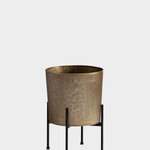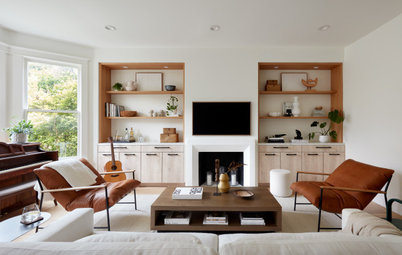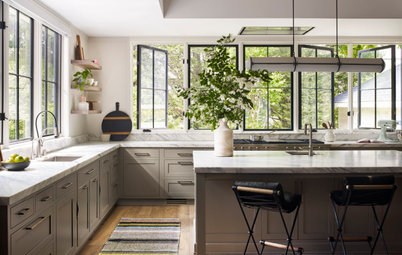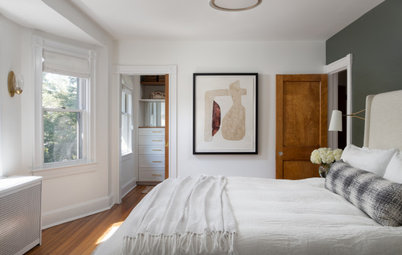Landscape Design
7 Eco-Friendly Updates to Help Cool Your Home
Consider these energy-saving ways to reduce indoor temperatures on hot days
With the hot days of summer upon us — and some areas experiencing extreme temperatures — it’s a good time to assess your home and ensure you’re as prepared as possible for the next heat wave. Here are seven energy-saving steps you can take to help keep your home cool.
2. Install Thermal Window Coverings
While we might be more used to thinking of heavy thermal blinds and curtains as features that cozy up a room in winter, they can also keep the same room cool in summer. Making sure the window treatments are tightly closed during a heatwave can help limit the temperature rise indoors.
Look for curtains, blinds and shades that block both light and UV rays. Make sure they completely cover the window so no light can seep in around the edges.
What to Know About 5 Popular Types of Window Shades
While we might be more used to thinking of heavy thermal blinds and curtains as features that cozy up a room in winter, they can also keep the same room cool in summer. Making sure the window treatments are tightly closed during a heatwave can help limit the temperature rise indoors.
Look for curtains, blinds and shades that block both light and UV rays. Make sure they completely cover the window so no light can seep in around the edges.
What to Know About 5 Popular Types of Window Shades
3. Consider Blinds, Shades or Film for Skylights
If you have skylights in your home, you might have struggled to keep temperatures down on hot days. With the sun directly overhead for several hours, rooms with skylights can get uncomfortably hot, even if you keep all other doors and windows closed and curtained.
To counteract this, look into getting shades or UV filters fitted to skylights. There are several options available, including solar film and fitted shades.
For the most effective solution, anti-heat blinds or shutters can also be fitted to the outside of skylights. These stop the sun’s rays from reaching the window panel, significantly reducing the heat that enters the room. You can combine these with interior blinds for maximum effect.
Shop for blinds, shades and curtains on Houzz
If you have skylights in your home, you might have struggled to keep temperatures down on hot days. With the sun directly overhead for several hours, rooms with skylights can get uncomfortably hot, even if you keep all other doors and windows closed and curtained.
To counteract this, look into getting shades or UV filters fitted to skylights. There are several options available, including solar film and fitted shades.
For the most effective solution, anti-heat blinds or shutters can also be fitted to the outside of skylights. These stop the sun’s rays from reaching the window panel, significantly reducing the heat that enters the room. You can combine these with interior blinds for maximum effect.
Shop for blinds, shades and curtains on Houzz
4. Add an Overhang or a Canopy
If you have south-facing windows, you could consider “passive shading” to help cut some of the glare and heat when temperatures rise. Options include projecting eaves, an overhang above the window, a fabric canopy, a pergola or a slatted brise-soleil.
Adding plants will also boost the cooling effect. Talk to a designer to get ideas for your home.
What to Know About Adding a Pergola
If you have south-facing windows, you could consider “passive shading” to help cut some of the glare and heat when temperatures rise. Options include projecting eaves, an overhang above the window, a fabric canopy, a pergola or a slatted brise-soleil.
Adding plants will also boost the cooling effect. Talk to a designer to get ideas for your home.
What to Know About Adding a Pergola
5. Audit Your Electrical Appliances
In addition to focusing on the heat entering your home from the outside, it’s worth looking at all the things inside that produce heat too. During hot weather, try reducing your use of electronic devices and appliances.
Inefficient lightbulbs, for example, can produce a surprising amount of heat. If you still have any incandescent or halogen bulbs, now’s the time to switch to LEDs, which get nowhere near as hot.
Kitchen appliances such as refrigerators and freezers also emit heat, particularly when they aren’t being used efficiently. Undertake some regular maintenance on yours, cleaning out air vents and defrosting to keep them running as efficiently as possible. If you need to upgrade an appliance, choose one with the highest energy efficiency rating.
Now is also a good time to get into the habit of taking devices off standby when they’re not in use, to reduce both energy consumption and heat.
In addition to focusing on the heat entering your home from the outside, it’s worth looking at all the things inside that produce heat too. During hot weather, try reducing your use of electronic devices and appliances.
Inefficient lightbulbs, for example, can produce a surprising amount of heat. If you still have any incandescent or halogen bulbs, now’s the time to switch to LEDs, which get nowhere near as hot.
Kitchen appliances such as refrigerators and freezers also emit heat, particularly when they aren’t being used efficiently. Undertake some regular maintenance on yours, cleaning out air vents and defrosting to keep them running as efficiently as possible. If you need to upgrade an appliance, choose one with the highest energy efficiency rating.
Now is also a good time to get into the habit of taking devices off standby when they’re not in use, to reduce both energy consumption and heat.
6. Grow a Tree
East- and west-facing rooms are harder to passively shade, but a deciduous tree should provide some protection in summer and let in daylight in winter.
“In the summer, the sun rises very early and, in east-facing rooms, it’ll be beating right in until around midday — meaning a full six or seven hours of it,” Sam Cooper of E2 Architecture + Interiors says. “With west-facing spaces, you’ll get the same, but in the afternoon. In this instance, growing a deciduous tree can be a good idea if possible.”
This is a longer-term measure, of course, but the sooner you plant your tree, the sooner you can feel the benefit of its shade.
Landscape Pros Share 10 Favorite Native Trees for Their Projects
East- and west-facing rooms are harder to passively shade, but a deciduous tree should provide some protection in summer and let in daylight in winter.
“In the summer, the sun rises very early and, in east-facing rooms, it’ll be beating right in until around midday — meaning a full six or seven hours of it,” Sam Cooper of E2 Architecture + Interiors says. “With west-facing spaces, you’ll get the same, but in the afternoon. In this instance, growing a deciduous tree can be a good idea if possible.”
This is a longer-term measure, of course, but the sooner you plant your tree, the sooner you can feel the benefit of its shade.
Landscape Pros Share 10 Favorite Native Trees for Their Projects
7. Green Up Your Exterior Walls
Creating a green screen on exterior walls and around windows and doors can help shade your interior and cool the walls of your home, making indoor temperatures a bit more comfortable.
Thinking about your yard in this way marks a shift from just considering the aesthetics to using plants to help protect and defend your home against the effects of climate change. A layer of greenery can also have the reverse effect in winter, keeping your walls warm and providing natural insulation when temperatures drop.
Some believe houseplants can also help to cool the air inside the home through transpiration, so introducing a few potted plants could also help to keep indoor spaces more comfortable.
Tell us: Have you tried any of these ideas in your own home? Share your experiences in the Comments.
More on Houzz
Read more stories about green building
Find a home professional
Shop for home products
Creating a green screen on exterior walls and around windows and doors can help shade your interior and cool the walls of your home, making indoor temperatures a bit more comfortable.
Thinking about your yard in this way marks a shift from just considering the aesthetics to using plants to help protect and defend your home against the effects of climate change. A layer of greenery can also have the reverse effect in winter, keeping your walls warm and providing natural insulation when temperatures drop.
Some believe houseplants can also help to cool the air inside the home through transpiration, so introducing a few potted plants could also help to keep indoor spaces more comfortable.
Tell us: Have you tried any of these ideas in your own home? Share your experiences in the Comments.
More on Houzz
Read more stories about green building
Find a home professional
Shop for home products






























If you have sash windows, you already have an early form of air conditioning at your fingertips. When the windows are opened at both the top and bottom, they provide quick and effective ventilation thanks to a convection flow of air. Cool air enters the room through the bottom of the window and warm air is then pushed out of the opening at the top.
If you have sash windows that have seen better days, now’s the time to get them fixed to make sure they’re working properly and can be correctly used to maximize airflow when temperatures rise. Or, if you’ve been considering having sash windows installed, it’s worth booking an appointment to talk to an expert now.
Find a window dealer near you